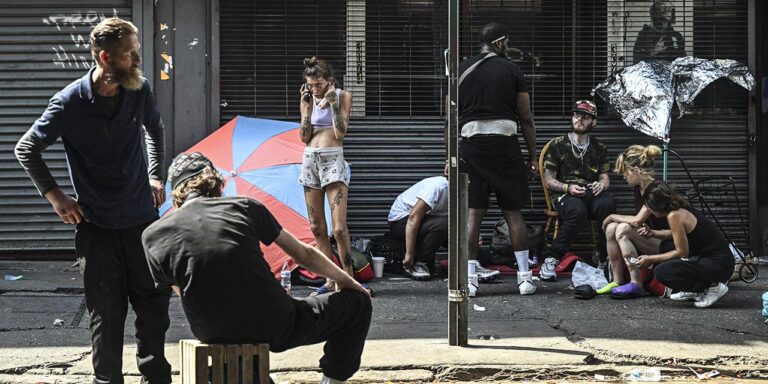Inside the East Coast’s Largest Open-Air Drug Market: Challenges and Solutions
Unraveling the Complex Ecosystem of the East Coast’s Open-Air Drug Market
Spanning a vast urban area, the East Coast’s most extensive open-air drug market operates through a sophisticated network of sellers, buyers, and law enforcement interactions. This illicit marketplace thrives on an intricate system of informal agreements and territorial boundaries that regulate competition among dealers. While rivalry is intense, violence is often strategically minimized to maintain uninterrupted trade. The clientele is diverse, ranging from habitual local users to occasional visitors, each exhibiting unique purchasing behaviors within the labyrinth of street vendors and corners.
Supporting this underground economy is a well-organized infrastructure featuring lookouts and couriers who facilitate swift product distribution and real-time communication to avoid police crackdowns. Dealers employ coded signals and discreet language to conduct transactions, balancing risk with high turnover rates.
- Hierarchy Among Vendors: Dominant dealers secure premium locations, overseeing smaller sellers.
- Varied Consumer Base: Demographic differences shape demand patterns and product availability.
- Law Enforcement Approaches: Frequent raids and undercover operations face resistance from local communities.
| Feature | Details |
|---|---|
| Peak Operating Hours | Evening to Midnight (5 PM – 12 AM) |
| Predominant Drugs | Heroin, Cocaine, Fentanyl |
| Typical Purchase Amount | $20 to $100 |
| Police Presence | High but sporadic |
Impact on Neighborhoods and Public Safety Concerns
The pervasive presence of this open-air drug market has profoundly reshaped the social and economic landscape of adjacent communities. Property values have sharply declined, with many businesses closing and public spaces falling into neglect. Residents frequently express feelings of insecurity, as violent altercations and unpredictable dealer interactions become commonplace. Community advocates stress that the issue transcends crime statistics, eroding social trust and hindering neighborhood revitalization efforts.
Public safety agencies face ongoing difficulties managing the market’s scale and openness, which stretch resources thin and complicate enforcement. Conventional policing methods often prove insufficient due to community skepticism and the market’s fluid nature. Key challenges include:
- Rising Violence: Territorial conflicts escalate tensions and incidents.
- Strained Emergency Services: Increased calls related to overdoses and disputes.
- Barriers to Reporting: Fear and mistrust discourage residents from cooperating with authorities.
- Visible Drug Activity: Discourages investment and deters new residents.
| Area Affected | Consequences | Community Voices |
|---|---|---|
| Health | Spike in overdose incidents | “Too many young lives lost.” |
| Economy | Business shutdowns and unemployment | “Stores are closing; no future here.” |
| Law Enforcement | Low case resolution and officer fatigue | “We‚Äôre stretched beyond capacity.” |
Law Enforcement Responses and Operational Challenges
Authorities tasked with policing this expansive drug market confront a range of tactical and logistical obstacles. The high volume of illicit sales is compounded by dealers’ use of advanced lookout systems and rapid communication to avoid detection. Traditional policing techniques often lag behind the agility and local expertise of vendors, necessitating continuous adaptation and innovation by law enforcement agencies.
Effective strategies include:
- Embedding undercover agents who can seamlessly integrate with both sellers and buyers.
- Employing real-time surveillance combined with predictive analytics to forecast market trends.
- Fostering collaboration across local, state, and federal law enforcement bodies.
Beyond street-level enforcement, socio-economic realities complicate efforts to dismantle the market. Disruptive actions risk displacing drug activity or increasing dangers for residents. Legal hurdles such as evidentiary standards and court backlogs further delay prosecutions.
| Challenge | Law Enforcement Strategy |
|---|---|
| Frequent dealer turnover | Targeting higher-level network leaders |
| Community mistrust | Implementing community policing programs |
| Rapid communication among dealers | Intercepting electronic signals |
| Insufficient evidence for prosecution | Utilizing body cameras and drone surveillance |
Strategic Policy Initiatives for Long-Term Urban Renewal
Addressing the entrenched issues posed by open-air drug markets demands a comprehensive, community-centered approach focused on resilience and equitable development. Expanding affordable housing options can reduce displacement pressures and stabilize neighborhoods, providing residents with safer living conditions and diminishing economic incentives for illicit trade. Integrating these housing efforts with enhanced mental health and addiction treatment services tackles the root causes of substance abuse, promoting sustainable recovery rather than temporary suppression.
Additionally, investing in workforce development programs tailored to local economic needs empowers marginalized groups by offering legitimate employment pathways. Effective implementation hinges on robust partnerships among law enforcement, public health agencies, and community organizations, enabling holistic, data-driven interventions that balance security with social support.
| Policy Focus | Main Goal | Anticipated Result |
|---|---|---|
| Affordable Housing Development | Prevent Resident Displacement | Stronger, Stable Communities |
| Expansion of Addiction Services | Facilitate Recovery | Reduced Relapse Rates |
| Job Training and Employment Programs | Promote Economic Inclusion | Lower Crime Incidence |
| Community-Oriented Policing | Build Trust | Enhanced Public Safety |
Ongoing evaluation using measurable outcomes is critical to ensure these policies adapt to evolving community needs. Sustained leadership commitment is vital to transform these challenging urban environments into vibrant, inclusive neighborhoods.
Final Thoughts
The East Coast’s largest open-air drug market remains a formidable challenge, deeply intertwined with broader social and economic factors. While law enforcement intensifies efforts through innovative tactics and increased patrols, residents and business owners advocate for comprehensive solutions that extend beyond policing. Gaining a nuanced understanding of the market’s inner workings is essential to tackling its root causes and fostering safer, healthier communities for the future.








